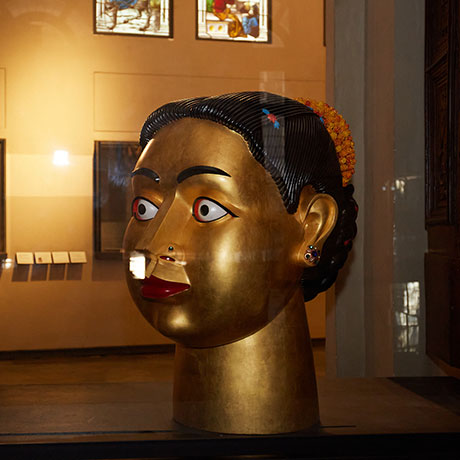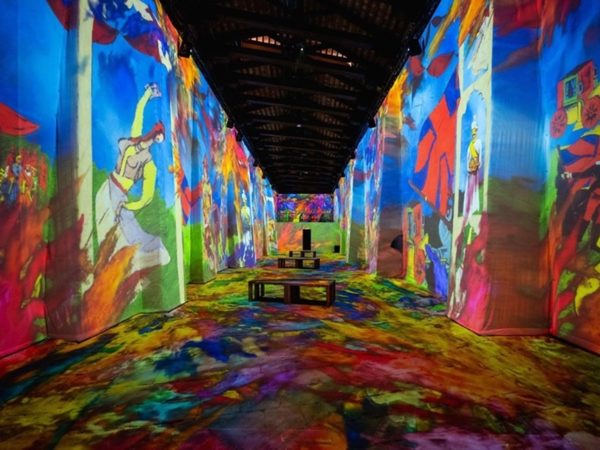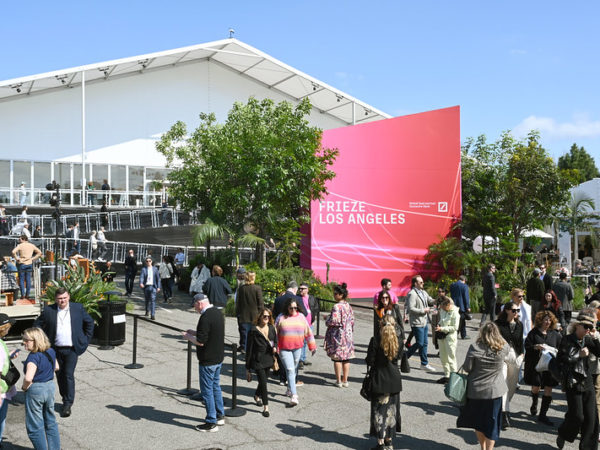ARTISSIMA ITALY: A COMEBACK WITH INDIA BEING A SURPRISING FOCUS
Hub India thrills audiences with a prolific exploration of the many registers that frame Contemporary art from the Indian Sub-Continent
Returning from the packed Art Week at Turin, the India Art Hub curator Myna Mukherjee reported that the response to the artworks from India art was “Intense and overwhelming, although the influx of the public could not be as mammoth as it usually is, given the COVID regulations, it was still very gratifying to see critics, collectors and the general public’s excitement about the diversity of works and the sense of discovery they experienced especially with those artists whose works haven’t been seen in the West earlier,” she avers.
In fact, Hub India was featured as one of the ‘big hits’ by leading art magazines like Artribune, Il Giornale Dell’ Arte, ARTFORUM, and ARTNET. The exhibition featuring over 65 Indian Artists from India’s leading galleries, curated by Mukherjee and David Quadrio was at various locations: at the Artissima Art Fair, Oval Lingotto, the Classical Radical exhibition at Museo d’Arte Orientale (MAO), and the Accademia Albertina di Bella Arti museums and the Palazzo Madama that is ongoing till the 5th of December 2021. Mukherjee indicates that the museum shows may be extended further.
His Excellency Vincenzo de Luca, Ambassador, Embassy of Italy in India, New Delhi projects Artissima as, “An innovative project between Italy and India to learn the ways of contemporary art whose roots are in the art of two great civilizations,” says de Luca. The exhibition is supported by the Consulate General of India, the Indian Council for Cultural Relations, and the Kiran Nadar Museum of Art (KNMA), and in collaboration with Artissima, Fondazione Torino Musei.
“Hub India is a concerted effort to present modern and contemporary Indian art on an expansive scale for the first time in Italy, conceptualized as a panorama of disparate
vignettes that will reveal the complexity and richness of artistic practice in India, drawn simultaneously to the past and to the possibilities of the future,” says Roobina
Karode, Director and Chief Curator, KNMA.
“Nature Morte is thrilled to be part of and support Artissima’s Hub India and the museum shows. It has been sensitively curated but with a level of precision that’s rare,” says director Aparajita Jain. “It is a historic undertaking for contemporary art from South Asia in the beautiful city of Turin,” adds co-director and curator Peter Nagy who was present at the event and has featured artists like Bharti Kher and Martand Kholsa.
Speaking about the entire experience of mounting an exhibition of this stature in our difficult times, Bhavna Kakar says, “Art is one of the industries that require a lot of travel and mass culture. COVID-19 has taken a big toll on the art world. Amidst a lot of art fairs being called off and galleries moving to virtual viewing – experience; we too had our fair share of troubles, postponing and canceling many of our international projects last year. Now it feels amazing to see things getting back to normal,” she says.
“We are delighted to be a part of Artissima fair, a contemporary Italian art fair of international reference. It feels even more special as we are exhibiting in Hub India, along with our contemporaries, which specifically focuses on the Indian contemporary art scene. It’s the first time a city-wide spectacle has taken place with India in focus,” adds Kakar.
The 28th edition of Artissima, with its theme ‘Controtempo’ (backbeat), metaphorically poses a strong question that how can art activate a change of pace and transform the fragilities of society into strong points, in these critical times. Hub India with its wide bandwidth of artists featuring works that are so diverse is making a significant contribution to the fair. Also leaving an indelible mark of the Indian subcontinent artists’, in the global contemporary art world.
LATITUDE 28’s artists presented at the different venues are Niyeti Chadha Kanal, Sudipta Das, Noor Ali Chagani, Chandan Bez Baruah, Khadim Ali, Waswo X Waswo, Wardha Shabbir, Waseem Ahmed, Gopa Trivedi, Priyanka D’Souza, and Rahul Kumar’s works.
Gopa Trivedi’s works are exhibited in Classical Radical – Multitudes & Assemblages – Accademia Albertina di Bella Arti. Her works attempt to address social and individual anxieties by creating subversive idioms using seemingly insignificant spaces or objects. The working process incorporates characteristics and implications specifically related to time, degeneration, and fragmentation.
The images and forms are used as metaphors that reflect the social and political concerns of her surroundings and time. Her sensibilities are deeply rooted in the Indian Miniaturist traditions, where she attempts to re-infuse and often re-contextualize miniature court styles by fusing traditional painting methods with new media.
Wardha Shabbir’s works are also exhibited in Classical Radical – Multitudes & Assemblages – Accademia Albertina di Bella Arti. The artist uses surrounding spaces as a continuity of her canvas, Wardha has moved on to create new ‘spaces’ within the paintings themselves, in form of passages, enclosures, and sometimes even light. She constructs maps, not just to familiarize herself with the spaces, but also subconsciously to navigate through the past and future as a means of returning to the self.
Art Alive, besides, having well-known names like Sakti Burman, Paresh Maiety and Singh Twins showcased three young contemporary artists, Chandrashekar Koteshwar, Ghana Shyam Latua and Teja Gavankar for Hub India at Artissima ’21. Chandrashekar Koteshwar’s works try to explore museological disciplinary consistencies of the display and meaning of certain objects. He creates objects which resemble historical artefacts and pokes fun at the importance, assigned to those artefacts.
Ghana Shyam Latua’s artistic practice is based on the conflict between natural and
artificial, the man-made environment. Belonging to a rural background, the poignant
sagas of land acquisition, the environmental, migrant crisis and modern-day slavery of tenured labour really affects him as an artist. Through his art and in his personalized manner, he tries to foreground these subjects in his works.
The ongoing exhibition in Palazzo Madama explores syncretism and hybridity through mostly three-dimensional works, that connect and juxtapose the outstanding collection in the Palace with the history of the Indian subcontinent, suggesting complicated histories of trading, religious exchange and dominations, imperialist remains and syncretic evolutions. Creating a hybrid imagery that is both veiled and provocative, ultimately reveals narratives and relationships with a Eurasian perspective.
The artists featured for this section are Jayashree Chakravarty, Sudipta Das, Tanya Goel, Ranbir Kaleka, Manjunath Kamath, Benitha Perciyal, G Ravinder Reddy, Gulam Mohammed Sheikh, Ayesha Singh, and LN Tallur.
The exhibition in MAO comprises contemporary renaissance composites that both iconize and obliterate the very classicism they refer to. One of the highlights of the exhibition is a radical section of neo-miniaturists, who borrow from the evocative stylized and gemlike ornamentation of traditional miniature styles and Wasli paintings but are subversive and explore ways to stretch and pull apart the vocabulary of a seemingly insular style.
The artists featured in this segment are Waseem Ahmad, Khadim Ali, Anindita Bhattacharya, Sakti Burman, Sudipta Das, Priyanka D’Souza, Baaraan Ijlal, Manjunath Kamath, Puneet Kaushik, Samanta Batra Mehta, Piyali Sadhukhan, Paula Sengupta, Yugal Kishore Sharma, Nilima Sheikh, The Singh Twins, Gopa Trivedi, Waswo X Waswo.
Finally, the Accademia Albertina di Belle Arti featured Multitudes & Assemblages. The trajectory of visual art in India is one of the multiple transitions; it spans and internalizes the wider discourses of colonialism, nationalism and international modernism.
The artists featured here are a long list, artists: Harshit Agrawal in collaboration with 64/1, Chandra Bhattacharjee, Sakti Burman, Sheba Chhachhi, Jogen Chowdhury, Priyanka D’Souza, Tanya Goel, Laxma Goud, Ganesh Haloi, Manjunath Kamath, Puneet Kaushik, Bharti Kher, Martand Khosla, Neerja Kothari, Amina Ahmed, Rahul Kumar, Tayeba Begum Lipi, Shruti Mahajan and Ravindra G. Rao, Paresh Maity, Debasish Mukherjee, Manish Pushkale, Mona Rai, Rekha Rodwittiya, Debanjan Roy, Prasanta Sahu, Shailesh BR, Shambhavi, Gulam Mohammed Sheikh, Ayesha Singh, and Abhimanyu Dalal.
Hub India project has certainly had an impact that will leave the European and Italian art scene talking about the Indian perspective no doubt as the highlight of the art season and the return to the physical viewing of art.
Text Georgina Maddox
Image courtesy: Engendered Arts and Artissima, Paula Sengupta, Ghulam Mohammed Sheikh, Waswo X Waswo, Ravinder Reddy, Anindita Bhattacharya, Nilima Sheikh, Sheba Chhachhi, Volte Gallery, Espace Gallery, Emami Art Gallery, Kiran Nadar Museum of Art
Find more about Hub India and participating Galleries and Artists:
https://news.artnet.com/buyers-guide/artissima-hub-india-2021-2029398
https://news.artnet.com/market/artissima-contemporary-art-fair-turin-italy-2021-2030584











